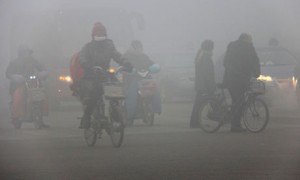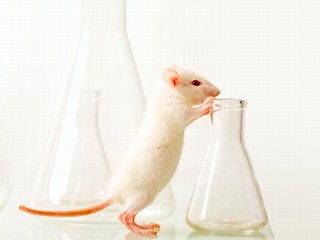Posts Tagged ‘environmental health’
Another Study Reveals Why Our System of “Safe Levels” is a Tragic Mirage
 Gas well, cement plant, lead smelter, plastics plant, refinery, compressor, incinerator. Anyone who's ever lived next door to an industrial polluter knows there's the way the facility appears to be operating on paper and how it's actually operating in the real world.
Gas well, cement plant, lead smelter, plastics plant, refinery, compressor, incinerator. Anyone who's ever lived next door to an industrial polluter knows there's the way the facility appears to be operating on paper and how it's actually operating in the real world.
The way it's operating on paper is completely portable. You can take this version of the facility anywhere. The numbers and printouts and charts can show up to congressional hearings. They can be included in PowerPoint presentations, along with glossy pics of the place itself. They can be summarized. They have no smell. They have no texture. They don't make a sound. On paper, expressed in language and figures, the facility may seem to be operating properly under every permitted limit it has to abide by.
On the ground however, it may be a completely different story. It may mean strange petrochemical or plastic smells wafting through your house in the middle of the night. It could mean a series of loud explosions or pops that nobody has ever been able to explain to you. It could mean rashes on your skin, or headaches, or nausea, or asthma attacks. It could mean living in fear of chemical assault. All the time.
This version of operations is not portable. One can write about it or talk about it, but that will not put other people there. And indeed, descriptions of these circumstances can sound so nightmarish that listeners assume you're exaggerating. You're not. Not even video or film can immerse you in it. No amount of reporting about it can make you feel in it. The map is not the place. The only way to know this side of operations is to live it. Day in, day out.
The difference between what the paper version of polluting says, and what the people living it know, is a front line of social justice in the 21st Century.
It also happens to be a major frontline for science, as demonstrated by a recent landmark study from, of all places, Texas Tech about how the sum of pollution is greater than its sometimes desperate parts We're late in covering this, but thanks to the Denton Record Chronicle's for bringing it to our attention back in June. Because this study underscores once again in a big way why our entire system of regulating chemical exposures is so completely contrary to what we know about how those exposures are affecting us.
Tech scientists took two chemicals that are known to cause cancer in large amounts, arsenic and estrogen, and exposed human prostate cells to very low amounts of each. The amounts they exposed the prostate cells to were so low, they fell below the EPA regulatory "safe" level that limits releases of the chemicals from polluters. Individually, the exposures of the cells to arsenic and estrogen were so low as to believed to be harmless. But they weren't.
Instead, the Tech researcher's peer-reviewed, journal-published study found the combination of the low doses of the two chemicals combined was almost twice as likely to create cancer in the prostate cells as the single chemical exposures individually. That is, the toxic interaction or "cumulative effect" of the two chemicals was more than the sum of their parts. There was a "synergestic" reaction inside the cells that the current regulatory system doesn't recognize as even a possibility.
“The majority of cancers are caused by environmental influences,” Singh said. “Only about 5 to 10 percent of cancers are due to genetic predisposition. Science has looked at these chemicals, such as arsenic, and tested them in a lab to find the amounts that may cause cancer. But that’s just a single chemical in a single test. In the real world, we are getting exposed to many chemicals at once.”
Singh became interested in looking at arsenic because water well problems in his native India had recently highlighted mass poisonings from contamination of the chemical. He wondered how this exposure would interact with other carcinogens within the same population.
He focused on estrogen as the second chemical because of the chemical’s ubiquity. Many plastics, such as food can liners, release bisphenol A (BPA), and other chemicals that mimic estrogen in the body.
Unlike more potent chemicals that do major damage to the DNA in a cell, such as benzene, arsenic and estrogen aren’t major mutagens Singh said. Instead, their presence tends to stop certain genes from expressing. The process is called DNA hypermethylation.
…the two chemicals stopped the MLH1 gene, which is responsible for sending the signal to start the self-destruct sequence when a cell is damaged. Because the self-destruct couldn’t activate, the cells became cancerous after exposure.
“With the lower dose not killing the cell, it’s causing damages that go under the cell’s radar. We found when you have two compounds together, lower doses could be more serious problem.”
This is what's called a non-linear impact. You can actually get harmed more by long term low-level exposures than by intense bursts of short term exposure – exactly the opposite of the way the system regulates chemical exposures now.
Currently that system assumes it can protect the public health from exposures to over 80,000 chemicals on the marketplace by regulating the average intake of these chemicals one at a time. It says: "we know that lead and benzene are bad for you if you OD on them, but by only exposing you to a little bit every day, we can keep you from getting damaged by its health effects." The dose is the poison. A little bit cant hurt you, but a lot can kill you.
Unfortunately, this view, which is the foundation for all modern regulatory schemes for chemical pollution, is based on a worldview of human physiology that's now dangerously out of date. For the past 50 years at least, study after study has shown that there are a lot of less-than-drop-dead health effects that couldn't be diagnosed without modern technology. The more we learn about how how bodies work the more we learn new ways about how chemicals can really screw them up. The Tech study is just the latest, albeit dramatic example.
Moreover, of those 80,00 chemicals only about 200 can be said to have been studied even remotely "thoroughly" and fewer that that have been examined for their interactions with any of the other 79,999. So the system itself is a big fat theory in progress, with very little real science supporting it. We're all its Guinea Pigs. It's an hypothesis.
But its a hypothesis with billions invested in it. So to prove it wrong is to threaten a lot of people with a lot of money.
Which is why the chemical industrial-government complex is trying very hard to hold back the tide of this kind of science and what it means. Meanwhile the gap between the paper version of how things are operating at a facility and the real world impact of those operations continue to grow. At some point the contradictions will be too much to ignore or withstand. But we're a long way from that point yet. Which is why we need your help to keep fighting on behalf of those folks living the truth on the ground and prevent more victims of this obsolete and harmful regulatory system.
Study: 2 Million Air Pollution Deaths Annually Worldwide, 77,000 in US
 We're a bit behind the curve in reporting on this, but scientists at the University of North Carolina just published a study in "Environmetnal Research Letters" that estimates Particulate Matter and Ozone pollution in the air is responsible for approximately 2.2 million deaths worldwide every year.
We're a bit behind the curve in reporting on this, but scientists at the University of North Carolina just published a study in "Environmetnal Research Letters" that estimates Particulate Matter and Ozone pollution in the air is responsible for approximately 2.2 million deaths worldwide every year.
Long-timers already know about how insidious Particulate Matter can be, but this only chronicles the hardcore fatal respiratory and cardiovascular impacts, concluding the tiny particles of soot cause at least 2.1 million deaths every year while ozone pollution shortens another 500,000 lives.
"East Asia," aka China, accounts for fully have of both those figures. India for another third. In North America, the casualties include 43,000 premature deaths from PM pollution and 33,000 from ozone.
Jason West, co-author of the study said: "Outdoor air pollution is an important problem and among the most important environmental risk factors for health."
Although alarming, these numbers are all underestimates of the health impacts of both of these pollutants, since they exclude anything other than fatalities. Besides making it harder to breathe, PM pollution has been linked to brain disorders and immune system disruptions.
Another Study Links Autism to Air Pollution
 The more Ozone and Particulate Matter pollution a baby in the womb is exposed to, the more likely he or she will be born with autism according to a new UCLA study published March 1st in Environmental Health Perspectives, a peer-reviewed journal published by the National Institute of Environmental Health Sciences. It's the largest study of its kind to date and is the first to link autism with ozone, or smog, levels.
The more Ozone and Particulate Matter pollution a baby in the womb is exposed to, the more likely he or she will be born with autism according to a new UCLA study published March 1st in Environmental Health Perspectives, a peer-reviewed journal published by the National Institute of Environmental Health Sciences. It's the largest study of its kind to date and is the first to link autism with ozone, or smog, levels.
Researchers compared levels of air pollutants, mostly related to vehicle traffic, during pregnancy gestation periods of 7,603 children with autism and 75,635 children without autism, born from 1995 to 2006 in Los Angeles. Babies at the 75th percentile of exposure to toxins had a 8 percent to 10 percent higher risk of autism than babies at the bottom 25th percentile, the study said. Ozone and fine particulates had the strongest association with autism.
Using government air monitoring stations, researchers estimated average exposures during pregnancy to carbon monoxide, nitrogen dioxide, nitric oxide, ozone and particulate matter. The study adjusted for factors that include maternal age, birthplace, race and education. Using birth certificates, researchers compared control children with non-control children who had matching birth year, sex and gestational age at birth.
"These findings are of concern, since traffic-related air pollution is ubiquitous," said Dr. Beate Ritz, chair of UCLA's Department of Epidemiology and the study's senior author. She said she was reluctant to advise expectant mothers to leave LA or polluted cities, because that's not an option for many. "We can't tell them to not breathe or not go outside or not go to work," she said. She did recommend avoiding sitting in traffic, when pollutant exposure is worst."
Autism is a spectrum of disorders ranging from a profound inability to communicate and mental retardation to milder symptoms seen in Asperger's syndrome. The Centers for Disease Control and Prevention estimates that autism affects one in every 88 children born in the U.S., a 25 percent increase from 2006.
Research on autism and exposure to chemicals has been limited. Studies from 2006 and 2010 found an association between autism and air pollutants from industries and other sources.
A study in 2010 was the first to look at autism and toxins specifically from auto exhaust. The study, based in California, reported that children born to mothers living within 9/10 mile of a freeway during pregnancy were more likely to be diagnosed with autism than children whose mothers lived more than 1/4 mile from a freeway. However, the sample size — 304 autism cases and 259 controls — was much smaller than the just-published UCLA study.
Most policy discussions concerning air pollution in DFW surround the damage done to lungs, or maybe hearts and lungs. Rarely are the other, now well-known associations between air pollution and birth defects, or air pollution and brain function mentioned. And even rarer is the fact mentioned that these harms are often occurring at levels of pollution considered to be officially "safe" or at least legal. We really have no idea what the assault on our bodies by chemicals we involuntarily breathe actually can do to our health over the long term. That's why we should minimize exposure to them as much as possible. And that means limiting the chemicals' movements, not those of expectant moms.
Congressional Report: Environmental Causes of Breast Cancer Must be Researched
 "Most cases of breast cancer “occur in people with no family history,” suggesting that “environmental factors — broadly defined — must play a major role in the etiology of the disease.” That's the conclusion of something called the Interagency Breast Cancer and Environmental Research Coordinating Committee, which came out with a report last week.
"Most cases of breast cancer “occur in people with no family history,” suggesting that “environmental factors — broadly defined — must play a major role in the etiology of the disease.” That's the conclusion of something called the Interagency Breast Cancer and Environmental Research Coordinating Committee, which came out with a report last week.
In 2012, Breast cancer was diagnosed in 227,000 women, killed 40,000, and cost more than $17 billion to treat in the United States.
Yet only a fraction of federal research funding has gone toward examining links between breast cancer and ubiquitous chemicals such as the plastic hardening agent bisphenol A; the herbicide atrazine; and dioxin, a byproduct of plastics manufacturing and burning, says the report, prepared for Health and Human Services Secretary Kathleen Sebelius.
“National survey data show that many of these chemicals are present in the blood or urine of children and adults in the United States, and some EDCs are present in 100 percent of the people sampled. Exposure to such compounds early in life can be especially dangerous, the report says.
All told, some 84,000 chemicals are registered for use in the United States. But complete toxicological screening data are available for only 7 percent of these substances, says the report, which calls for “enhanced testing of chemicals, especially classes of chemicals combined together as a mixture, for effects on the mammary gland and breast …”
“Prevention needs to be as important as other investments that are made in screening, treatment and access to care,” Jeanne Rizzo, co-chair of the committee and president of the San Francisco-based Breast Cancer Fund said in an interview. “There really is a problem, and until we address it we’re going to continue to have a quarter of a million new cases every year.”
The report’s release comes three months after a Center for Public Integrity article detailing a study of female plastic automotive parts workers in Windsor, Ontario. That study found that women employed in the chemical-intensive industry were nearly five times as likely to develop breast cancer, prior to menopause, as women in a control group.
“That was essentially an uncontrolled human study,” Rizzo said of the Windsor workers. “We can’t do that. We need to learn from animal studies.”
In the United States, an estimated 150,000 female workers in the plastics and synthetic rubber industries are likely exposed to many of the same chemicals as the women in Windsor, including polyvinyl chloride, or PVC, plastic; acrylonitrile; formaldehyde and styrene.
At least 216 chemicals, including endocrine-disrupting substances like bisphenol A, have been associated with mammary gland tumors in animals. Endocrine-disrupting chemicals, or EDCs, are used to make plastics and pesticides and found in products such as furniture, metal food cans and cosmetics.
But environmental exposures have gotten relatively little attention from researchers.
The National Institutes of Health spent almost $2.4 billion on 2,910 breast cancer research projects from fiscal year 2008 through fiscal year 2010. But only about 27 percent of these projects had to do with prevention, and just 10 percent could be considered “environmental health research.”
Of the $2.8 billion appropriated by Congress from 1992 through 2012 for the Department of Defense Breast Cancer Research Program, 75 percent went toward “basic biology and treatment research, with only 3 percent for prevention and cancer control projects."
The committee recommends that researchers prioritize “chemicals that are produced in high volumes for which there is biologically plausible evidence of their role in the development of breast cancer.”
It also suggests that regulators improve oversight of “cosmetics and personal care products as well as household cleaning and food containment products,” and step up environmental monitoring, especially of “underserved and under-researched groups as well as ‘fenceline’ communities that are in close proximity to industry or waste sites.”
Environmental Health News Round-Up
 Current events in Dallas and Frisco kept us off our usual Environmental Health beat for awhile. Here's a round-up to get caught-up with some of the most important recent news:
Current events in Dallas and Frisco kept us off our usual Environmental Health beat for awhile. Here's a round-up to get caught-up with some of the most important recent news:
Secondhand Smoke is a Big Source of Lead – Children in families with one smoker had lead levels 14 percent higher than children who live with non-smokers. That number jumped to 24 percent if children lived with two or more smokers according to a new John Hopkins study. The article is frustrating however because it doesn't say where the lead in cigarettes comes form
Phthalates Linked to Obesity in African-Americans – A new study shows that African-American children who have high levels of an environmental contaminant called phthalates are more likely to be obese.The study, published in Environmental Health Perspectives on Feb. 5, showed that African-American children had higher levels of the chemical compared to white and Hispanic children. Phthalates are found in plastics but also can be found in the gas patch and in the emissions of waste-burning cement plants like the ones in Midlothian.
The Cancer Risk of Fire Fighters – Tony Stefani used to be a firefighter and a cancer patient. The two, he believes, had something to do with each other.Stefani was a firefighter in his native San Francisco for 28 years, nearly half of them as captain of a rescue squad. But the profession he loved may have nearly cost him his health. The job involved breathing all kinds of substances, from the diesel fumes of fire engines to smoke laced with flame retardants in people's homes. That contact, Stefani believes, is the reason for his diagnosis of transitional cell carcinoma, a rare cancer in his pelvis, in 2001. He soon learned that hundreds of active and retired firefighters also had various kinds of cancer.
Pesticides Linked to Type 2 Diabetes – Pesticides in food, air and water may be directly linked with the development of type 2 diabetes, regardless of a person's age, gender or body mass index, a new Spanish research study has found. These substances tend to concentrate in body fat, and they might be one of the reasons why obese people are more likely to develop diabetes, since the greater the fat, the higher the pesticide concentrations in the body, researchers from the University of Granada found.
PAH's Make Cockroach Allergies More Likely – Results from a study published on Feb. 6 in the Journal of Allergy and Clinical Immunology found that exposure to a certain type of air pollution found in diesel exhaust and other combustion-related byproducts can increase the likelihood of developing a cockroach allergy. Researchers studied a common class of combustion byproducts called polycyclic aromatic hydrocarbons, which are products of combustion.
Another Study Ties Air Pollution to Lower Birth Weights – A pregnant woman's exposure to outdoor air pollution may increase the risk of her baby being born at a lower birth weight, according to a large multinational study. Researchers from 14 sites in nine countries, including Seoul, South Korea; Atlanta; and Vancouver, British Columbia, compiled the average levels of particulate air pollution to which women were exposed during the course of their pregnancy. Sources of particulate air pollution include traffic exhaust, power plants and even dust. The researchers found that for every 10-microgram increase of pollution particles per cubic meter of air, birth weight decreased by 8.9 grams, roughly one-third of an ounce, and infants were 3 percent more likely to be a low birth weight. An infant is considered low birth weight if he or she weighs less than 5 pounds 8 ounces at birth. Low birth weight is a known risk factor for infant mortality as well as heart, breathing and behavior problems later in life.
Breaking: Human Body More Nuanced than Science Thought
 How many times have you heard a local neighbor of a downwinder say something like, "I've lived here all my life and never once got sick from that stuff," even while the block they live on might be a cancer hotspot?
How many times have you heard a local neighbor of a downwinder say something like, "I've lived here all my life and never once got sick from that stuff," even while the block they live on might be a cancer hotspot?
There are lots of reasons for pollution not affecting everyne equally. One is the new science of "Epigenetics," which has discovered that an ancestor's exposure to environmental toxins that never affected them could skip a generation or two and result in disease or illness many decades past the original transgression.
Via the New York Times this week comes another explanation that concludes there are a lot more ways environmental toxins can affect DNA behavior other than corrupting the DNA itself. What scientists believed were mostly unused parts of the human genome turn out to be huge, complex switchboards for the controlling of all kinds of things related to DNA growth, maintenance, and damage.
"Now scientists have discovered a vital clue to unraveling these riddles. The human genome is packed with at least four million gene switches that reside in bits of DNA that once were dismissed as “junk” but that turn out to play critical roles in controlling how cells, organs and other tissues behave. The discovery, considered a major medical and scientific breakthrough, has enormous implications for human health because many complex diseases appear to be caused by tiny changes in hundreds of gene switches.
The findings, which are the fruit of an immense federal project involving 440 scientists from 32 laboratories around the world, will have immediate applications for understanding how alterations in the non-gene parts of DNA contribute to human diseases, which may in turn lead to new drugs. They can also help explain how the environment can affect disease risk. In the case of identical twins, small changes in environmental exposure can slightly alter gene switches, with the result that one twin gets a disease and the other does not."
The article makes the connection between past research that found a likelihood to get certain diseases among those with corrupted DNA patterns, but until now, no one knew that those patterns were from the operation of on/off switches for genes in the DNA. This research, by building a "Google Map" of these switches, fills in the blanks and provides lots of new evidence of how subtle changes that fall short of breaking or damaging DNA can still result in harmful health effects, perhaps including many that are initiated by environmental toxins.
